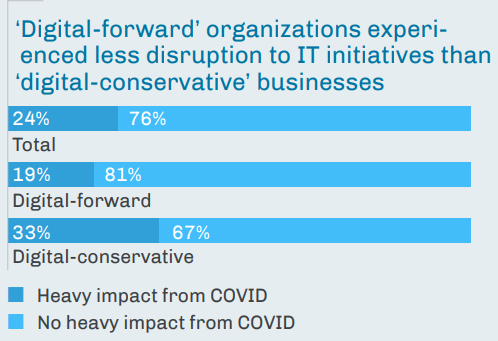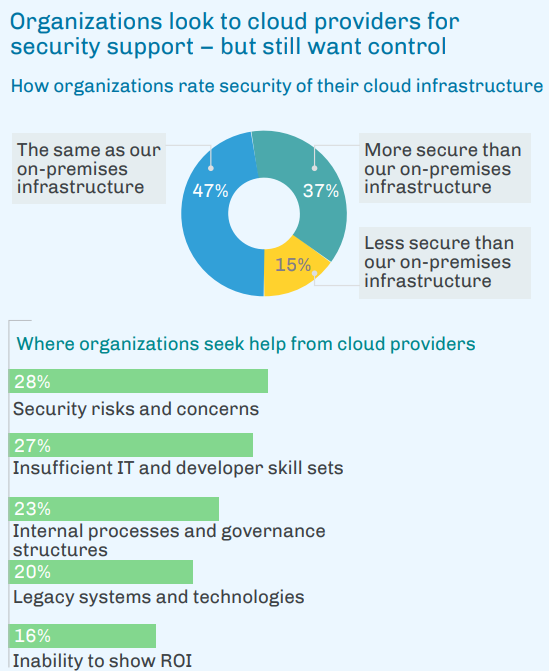
Introduction
“Digital transformation was supposed to be an ongoing journey—not the turn-on-a-dime situation most businesses were thrust into when COVID-19 first took hold around the globe.”
The COVID-19 pandemic completely upended business worldwide and forced unprecedented change to numerous aspects of working life. Organisations had to quickly adapt to newfound challenges – workspaces were forced to abandon due to lockdowns, furlough schemes put millions of staff on paid temporary leave, and where applicable organisations had to evolve their work-at-home policies to continue business remotely.
The pandemic created the ideal conditions for IT leaders and businesses to evaluate and address the current state of their digital infrastructure. Are they prioritising the cloud? Investing in data and analytics capabilities? Bolstering security across an evolving technology ecosystem?
These are savvy ways in which businesses can modernise, innovate and evolve their IT infrastructure to support the constantly changing dynamics of their business.
Organisations that had resilient digital infrastructures in place negated most of the negative effects that the COVID-19 pandemic had on the logistics of their operation and workforce.
The pandemic therefore highlighted the benefits of already having an advanced digital infrastructure in place more than ever. Cloud-based technologies and services have helped organisations rapidly support remote workforces, creating newfound levels of interconnectivity and customer support, despite workforces becoming more decentralised.
Research has found that digital innovation has been facilitated by the pandemic, bringing about numerous years worth of technological progress within the space of a one to two year period. According to a McKinsey Global Survey of executives, the participating companies accelerated the digitisation of their customer and supply-chain interactions by three to four years, and the share of digital or digitally enabled products in their portfolios by seven years.
So, as well as the plethora of adverse effects that the pandemic has had on businesses, for some it has pressured decision makers into analysing and reshaping their digital agendas, forcing IT leaders to create new ways to operate and innovate.
A survey of 2,000 IT leaders shows acceleration of multicloud, analytics, sustainability, and security
New research commissioned by Google Cloud in partnership with IDG has surveyed more than 2,000 IT leaders worldwide to understand the current state of digital transformation, the impact of the global pandemic on core IT initiatives, and the capabilities organisations want from their cloud providers.
The findings in the study can help IT leaders to evaluate their own cloud transformation efforts and help them to future proof their operations against business, market, or even societal disruptions. The findings may also be used to benchmark an organisation’s goals and challenges, to assess and better understand where an organisation’s priorities lie, whilst also inspiring new ways to operate and innovate.
Methodology
A 20-question online survey was fielded in October and November 2020. To qualify, organisations had to have at least some portion of their IT environment in the public cloud.
The respondents were IT Directors and above, at organisations with 500+ employees across multiple selected industries:
- Financial services
- Healthcare
- Manufacturing
- Telecom/media
- Retail/consumer goods
The survey was fielded in North America (United States, Canada), Latin America (Brazil, Mexico), EMEA (France, Germany, United Kingdom), and JAPAC (Australia, China, India, Indonesia, Japan, Singapore, South Korea).
COVID-19 impact: For better or worse
“Those with a more mature DX (digital transformation) strategy had the resources, tools, and insight lined up to quickly make tough decisions about how to proceed.” – IDC
A global IDC survey in June 2020 showed a clear connection between an organisation’s digital fitness and its ability to respond to, and recover from, pandemic-related challenges. Organisations who are deemed as ‘digital-forward’, meaning that they have advanced digital business strategies and the correct digital infrastructure in place, could better adapt to the challenges posed to them by the pandemic.
One such challenge was the decentralisation of staff due to lockdowns. Digital environments were created to allow workforces to continue working remotely, and it is therefore unsurprising that 59% of the organisations represented in the IDG survey had either accelerated or launched initiatives to improve remote work and collaboration capabilities.
This then had the knock-on effect of accelerating investment in the cloud. One-third of the participating organisations accelerated or launched initiatives to shift more workloads and software development to the cloud and automate manual business processes.

There were, however, also adverse effects from the COVID-19 pandemic that impacted organisations. The notable economic pressures that it imposed on many businesses worldwide forced decision makers to rethink their priorities and whether or not to invest in, or proceed with, certain pre-planned initiatives.
More than half of the survey respondents (55%) delayed or cancelled at least one technology project, such as core initiatives involving areas such as automation, digital customer experiences, and security tools and practices.
Those who were ill-equipped to mitigate the adverse effects of the pandemic on their operations, labelled in the study as ‘digitally conservative’ organisations, were more likely (16%) than their ‘digitally forward’ peers (8%) to have cancelled or delayed three or more IT initiatives.
Multi Cloud management needs increase
“Security enhancements and risk mitigation was identified as a main area where IT leaders are continuing their digital transformation efforts as they prepare for whatever the future holds.”
Due to businesses having decentralised workforces as a consequence of lockdowns, IT leaders began to prioritise investment in the cloud in order to bolster their digital accessibility, agility and adaptability. The cloud enabled remote workforces to easily access secure information from any location, making it ideal for businesses that implemented work from home policies.
Security enhancements and risk mitigation were identified in the study as the main area where IT leaders are continuing their digital transformation efforts as they prepare for whatever the future holds. 30% of the respondents surveyed globally said they accelerated and added new IT security tools (primarily through the cloud) during COVID-19. And the general sentiment (84%) from the respondents was that the cloud is as secure or more secure than their on-premises infrastructure, which further justifies investment.

Confidence, as opposed to complacency, is being placed in the cloud by IT leaders, but with this confidence also comes expectation. They expect cloud providers to deliver on specific security and compliance-related requirements, whilst also having the ability to use cloud services while still being able to control access to their own data.
Although IT departments might prefer the simplicity of working with a single public cloud platform, the downsides to sole dependency on a single cloud server can quickly outweigh the benefits.
With more emphasis being placed on the importance of data over recent years, ‘multi cloud’ has become the modern form of using a multi-vendor strategy to mitigate risk. If there is an issue with one cloud server and there are barriers to accessing information, businesses have an alternative backup cloud available to safeguard against any loss of data.
Two-thirds (66%) of the participating enterprise organisations in the study use multiple public clouds, citing a variety of benefits:
- Greater platform and service flexibility
- Improved disaster recovery and business continuity
- Best-of-breed platform and service options
- Cost savings/optimization
And this trend is predicted to grow in prevalence. The IDC predicts that by 2023 more than 70% of organisations will use multi cloud management platform capabilities as part of their managed cloud services portfolio, as IT leaders continue to prioritise investment in the cloud.
Summary
“The events of the past year catapulted digital transformation from being a somewhat abstract concept for some organisations into an essential reality. The COVID-19 pandemic drove home, in no uncertain terms, the importance of having advanced, flexible, and pervasive digital operations.”
As consistently alluded to throughout the study, organisations that were further ahead on the digital maturity path, were able to navigate 2020’s disruptions more smoothly and confidently than their digitally conservative peers. Having the correct structure in place turned out to be a blessing, however for those who were most affected by the pandemic it created an opportunity for reflection and investment.
Delocalised workforces highlighted the importance of the cloud and its ability to conveniently access information. The major public clouds are now seen by businesses as the best sources for many of the advanced technologies modern organisations require, and there is confidence that investing in them will better prepare organisations against future disruptions. Due to the pandemic emphasis has been placed on security and risk mitigation, therefore it is unsurprising that these were identified as the key area in which IT leaders are continuing their digital transformation and prioritising investment.
Download the whitepaper here >>
Posted by Joe on 27th September 2022.

